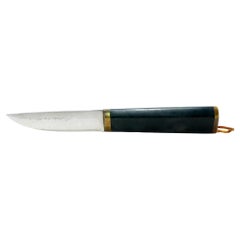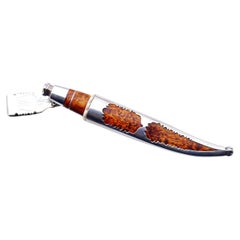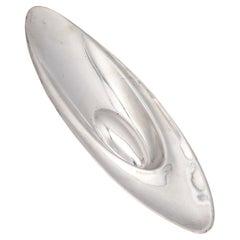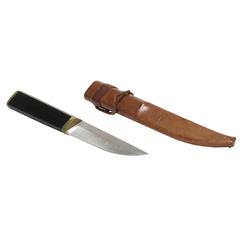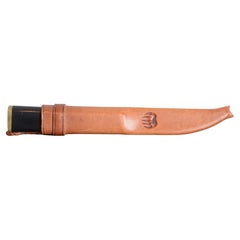Vintage Puukko Knife
Mid-20th Century Finnish Scandinavian Modern Vintage Puukko Knife
Brass, Stainless Steel
1980s Finnish Jugendstil Vintage Puukko Knife
Sterling Silver, Steel
1950s Finnish Mid-Century Modern Vintage Puukko Knife
Silver, Sterling Silver
Recent Sales
20th Century Finnish Scandinavian Modern Vintage Puukko Knife
Brass, Stainless Steel
Mid-20th Century Finnish Mid-Century Modern Vintage Puukko Knife
Brass
Mid-20th Century Finnish Mid-Century Modern Vintage Puukko Knife
Brass
Mid-20th Century Swedish Scandinavian Modern Vintage Puukko Knife
Brass, Steel
1960s Finnish Scandinavian Modern Vintage Puukko Knife
Stainless Steel, Brass
1960s Finnish Vintage Puukko Knife
Glass
1960s Finnish Scandinavian Modern Vintage Puukko Knife
Brass, Stainless Steel
People Also Browsed
2010s South African Minimalist Vintage Puukko Knife
Hardwood
2010s American Mid-Century Modern Vintage Puukko Knife
Brass, Nickel, Enamel, Bronze
21st Century and Contemporary Swedish Mid-Century Modern Vintage Puukko Knife
Textile
1960s Swedish Scandinavian Modern Vintage Puukko Knife
Mirror, Pine
1960s Italian Mid-Century Modern Vintage Puukko Knife
Metal
15th Century and Earlier Canadian Vintage Puukko Knife
Stone
1950s Danish Mid-Century Modern Vintage Puukko Knife
Aluminum
21st Century and Contemporary Italian Mid-Century Modern Vintage Puukko Knife
Brass
21st Century and Contemporary Indian Modern Vintage Puukko Knife
Iron
2010s Dutch Modern Vintage Puukko Knife
Marble
2010s American Modern Vintage Puukko Knife
Fiberglass
Mid-20th Century Belgian Vintage Puukko Knife
Wood
1880s Austrian Aesthetic Movement Vintage Puukko Knife
Silver
20th Century Swedish Scandinavian Modern Vintage Puukko Knife
Faux Leather, Birch, Teak, Plywood
1910s Swedish Aesthetic Movement Vintage Puukko Knife
Onyx, 18k Gold
21st Century and Contemporary British Modern Vintage Puukko Knife
Onyx, Yellow Gold
Tapio Wirkkala for sale on 1stDibs
Along with architect Alvar Aalto, the designer Tapio Wirkkala was Finland’s leading contributor to the Scandinavian interpretation of modernism in the mid-20th century. Prolific and innovative, Wirkkala excelled in a wide range of fields, including glass, furniture, porcelain, jewelry and tableware. The hallmark of his talent was an ability to impart a craft aesthetic based on natural forms — leaves, ice, bubbles, birds — to industrially produced designs.
A native of Helsinki, Wirkkala studied at the national School of Applied Arts and took up a career in graphic design. After serving in the Finnish army during World War II, he joined the glassmaking firm Iittala, an association that would continue to the end of his life. Wirkkala learned every aspect of glassmaking in keeping with his belief that an artist-designer should be involved in all stages of production. His best-known works for Iittala are vases and drinking vessels that resemble either carved ice or icicles. In 1956, Wirkkala began a long relationship with the porcelain maker Rosenthal, for whom he designed elegant table pieces, such as the Finlandia coffee service and the biomorphic Pollo vases.
House Beautiful magazine declared Wirkkala’s Leaf platter the “most beautiful object” of 1951. (The acclaim led to his brief employment stint with industrial designer Raymond Loewy in New York.) That platter was one of the first designs Wirkkala made using laminated sheets of plywood sanded to a smooth surface that resembles an abstract leaf. It would go on to become a motif in many Wirkkala furniture pieces — most notably in inlaid coffee tables for Asko — and in a sense these are the works most emblematic of his personal aesthetic.
Wirkkala was a traditionalist in many ways, but he had a modernist’s practical approach, incorporating his leaf-like spirals into simple, functional objects. That is the core attraction of Wirkkala’s designs: They stand out with a striking, sculptural energy yet blend in as part of a warm and comfortable decor.
Find vintage Tapio Wirkkala furniture on 1stDibs.
